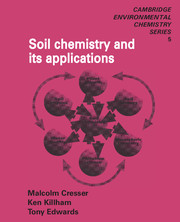3 - Soil organic matter
Published online by Cambridge University Press: 05 August 2012
Summary
Introduction
Although the total global reservoir of carbon is massive (more than 1019 kg), only a very small fraction of this carbon is actively involved in the fluxes of the carbon cycle, most of the Earth's carbon being locked away in sediments, in carbonate in oceans and in igneous rocks and fossil fuels. The Earth's active carbon pool consists of carbon in living organisms, carbon in the atmosphere and carbon in soil organic matter. It has been estimated that the mass of carbon in soil organic matter amounts to about 3 × 1015 kg and this is approximately five times the size of the atmospheric pool (Bohn, 1976). The latter pool is approximately the same size as that in living organisms.
Components of soil organic matter
Soil organic matter can, initially, be largely sub-divided into three main fractions:
(a) The decomposing residues of plants (as well as animals and microbes).
(b) The living soil biota – microorganisms, animals and plant roots.
(c) Resistant organic matter – chemically/physically protected.
Under most circumstances, more than 90% of soil organic matter is in resistant forms, although there is a continual flow of carbon from one pool to another. Figure 3.1 illustrates how this continual ‘processing’ of soil organic matter occurs. Generally, the system is in a state of dynamic equilibrium, with the organic matter pools remaining more or less constant with time.
Decomposing residues of plants
By far the most important input to soil organic matter is in the form of plant residues.
- Type
- Chapter
- Information
- Soil Chemistry and its Applications , pp. 28 - 57Publisher: Cambridge University PressPrint publication year: 1993
- 1
- Cited by



